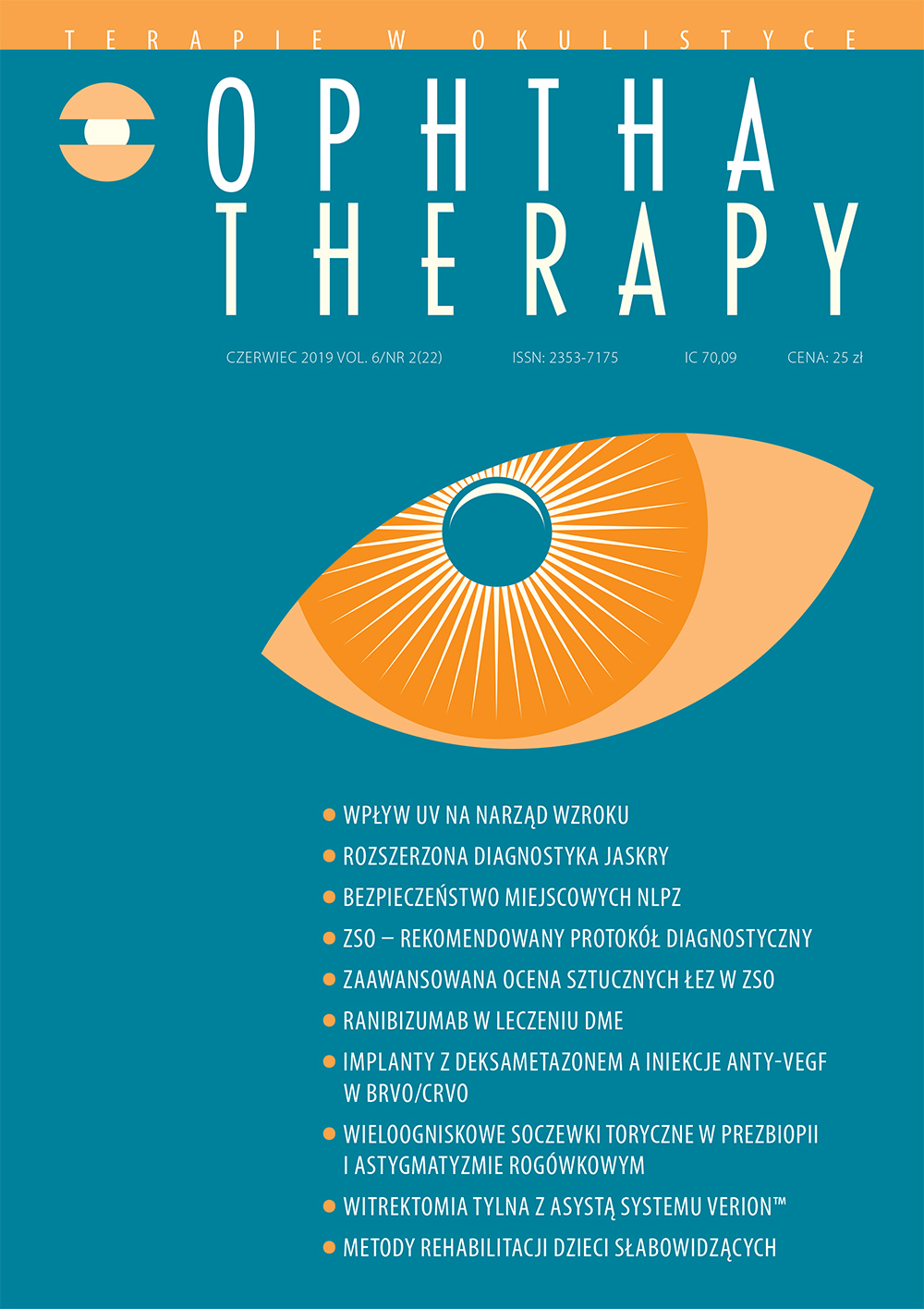Extended glaucoma diagnostics
Main Article Content
Abstract
Glaucomatous neuropathy diagnosis is based on recognizing typical changes in the optic disc image, the visual field, and imaging tests. A necessary part of the process is also an intraocular pressure examination (with a Goldmann applanation tonometer) and gonioscopy. In some particularly ambiguous cases, e.g., preperimetric glaucoma, low-tension glaucoma, high concomitant myopia, or difficult to evaluate atypical optic disc images (drusens, myelinated nerve fibres), routine examinations may not suffice. The following article presents less common diagnostic methods which may be useful in determining the patient’s condition and further treatment.
Downloads
Article Details

This work is licensed under a Creative Commons Attribution-NonCommercial-NoDerivatives 4.0 International License.
Copyright: © Medical Education sp. z o.o. License allowing third parties to copy and redistribute the material in any medium or format and to remix, transform, and build upon the material, provided the original work is properly cited and states its license.
Address reprint requests to: Medical Education, Marcin Kuźma (marcin.kuzma@mededu.pl)
References
2. Bowling B. Kanski. Okulistyka kliniczna. Szaflik J, Izdebska J (red wyd pol). Wyd. 8. Edra Urban & Partner, Wrocław 2017: 307-29.
3. Wytyczne Polskiego Towarzystwa Okulistycznego – leczenie jaskry. Aktualizacja: 2017 r. Online: https://www.pto.com.pl/wytyczne#-modalWider-576.
4. Grzybowski A. Okulistyka. Edra Urban & Partner, Wrocław 2018: 160-3.
5. Carbonaro F, Andrew T, Mackey DA et al. The heritability of corneal hysteresis and ocular pulse amplitude: a twin study. Ophthalmology. 2008; 115: 1545-9.
6. Deol M, Taylor DA, Radcliffe NM. Corneal hysteresis and its relevance to glaucoma. Curr Opin Ophthalmol. 2015; 26: 96-102. https://doi.org/10.1097/ICU0000000000000130.
7. Wasilewicz RH. W kierunku lepszego zrozumienia neuropatii jaskrowej. OpthaTherapy. 2014; 4(4): 246-51.
8. Wasyluk J, Spaeth G. Indywidualne kontra standardowe podejście do pacjenta – klucz do sukcesu w leczeniu jaskry. Zastosowanie skali DDLS i Colored Glaucoma Graph. OphthaTherapy. 2015; 4(8): 240-55.
9. Havvas I, Papaconstantinou D, Moschos MM et al. Comparison of SWAP and SAP on the point of glaucoma conversion. Clin Ophthalmol. 2013; 7: 1805-10.
10. Strehaianu MV, Dascalescu D, Ionescu C et al. The importance of ganglion cell complex in investigation in myopic patients. Rom J Ophthalmol. 2017; 61(4): 284-9.
11. Gupta D, Asrani S. Macular thickness analysis for glaucoma diagnosis and management. Taiwan J Ophthalmology. 2016; 6(1): 3-7.
12. Prost MR, Wasyluk J. Histopatologia uszkodzenia komórki zwojowej siatkówki a diagnostyka i monitorowanie jaskry. OphthaTherapy. 2017; 1(13): 36-41.
13. Sample PA, Bosworth CF, Weinreb RN. Short-Wavelengh Automated Perimetry and Motion Automated Perimetry in patients with glaucoma. Arch Ophthalmol. 1997; 115(9): 1129-33.
14. Kaczorowski K, Mulak M, Szumny D, Misiuk-Hojło M. Heidelberg Edge Perimeter: the new method of perimetry. Adv Clin Exp Med. 2015; 26(6): 1105-12. https://doi.org/10.17219/acem/43834.
15. Wall M, Montgomery EB. Using motion perimetry to detect visual field defects in patients with idiopatic intracranial hypertension: a comparison with conventional perimetry. Neurology. 1995; 45(6): 1169-75.
16. Herba E, Pojda SM, Zatorska B et al. Perymetria krótkofalowa – znaczenie w diagnostyce jaskry w krótkowzroczności. Klin Oczna. 2004; 1-2: 225-7.
17. Soliman MA, de Jong LA, Ismael AA et al. Standard achromatic perimetry, short wavelength automated perimetry and frequency doubling technology for detection of glaucoma damage. Ophthalmology. 2002; 109(3): 444-54.
18. Harris A, Moss A, Rusia D et al. Aktualne poglądy na naczyniowe czynniki ryzyka. Górnicki Wydawnictwo Medyczne, Wrocław 2010.
19. Stasiak K, Nowicki G. Zastosowanie ultrasonografii dopplerowskiej w okulistyce. OphthaTherapy. 2014; 3(3): 149-56.
20. Karczewicz D, Modrzejewska M, Kuprianowicz L. Ocena grubości warstwy włókien nerwowych siatkówki i przepływu krwi w naczyniach krwionośnych u chorych z jaskrą. Klin Oczna. 2002; 104(3-4): 207-10.
21. Synder A, Augustyniak E, Laudańska-Olszewska I et al. Ocena parametrów przepływu krwi w tętnicach rzęskowych tylnych krótkich u chorych z jaskrą pierwotną otwartego kąta przed i po leczeniu operacyjnym. Klin Oczna. 2004; 106(1-2): 206-8.
22. Lubiński W, Kirkiewicz M, Karaśkiewicz J. Elektroretinogram stymulowany wzorcem oraz fotopowa negatywna odpowiedź w diagnostyce jaskry. OphthaTherapy. 2017; 2(14): 73-80.
23. Podborączyńska-Jodko K, Lubiński W, Palacz O et al. Ocena funkcji bioelektrycznej komórek zwojowych za pomocą badania PERG u pacjentów z jaskrą normociśnieniową. Roczniki Pomorskiej Akademii Medycznej w Szczecinie 2007; 63(supl 1): 30-4.
24. Gołębiewska J, Hautz W. Zastosowanie angio-OCT w diagnostyce i terapii okulistycznej – część II. OphthaTherapy. 2016; 4(12): 254-9.
25. Mammo Z, Heisler M, Balaratnasingam C et al. Quantitative optical coherence tomography angiography of radial peripapillary capillaries in glaucoma, glaucoma suspect, and normal eyes. Am J Ophthalmol. 2016; 170: 41-9.

